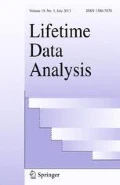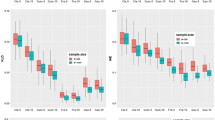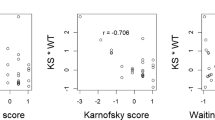Abstract
Copula models have become increasingly popular for modelling the dependence structure in multivariate survival data. The two-parameter Archimedean family of Power Variance Function (PVF) copulas includes the Clayton, Positive Stable (Gumbel) and Inverse Gaussian copulas as special or limiting cases, thus offers a unified approach to fitting these important copulas. Two-stage frequentist procedures for estimating the marginal distributions and the PVF copula have been suggested by Andersen (Lifetime Data Anal 11:333–350, 2005), Massonnet et al. (J Stat Plann Inference 139(11):3865–3877, 2009) and Prenen et al. (J R Stat Soc Ser B 79(2):483–505, 2017) which first estimate the marginal distributions and conditional on these in a second step to estimate the PVF copula parameters. Here we explore an one-stage Bayesian approach that simultaneously estimates the marginal and the PVF copula parameters. For the marginal distributions, we consider both parametric as well as semiparametric models. We propose a new method to simulate uniform pairs with PVF dependence structure based on conditional sampling for copulas and on numerical approximation to solve a target equation. In a simulation study, small sample properties of the Bayesian estimators are explored. We illustrate the usefulness of the methodology using data on times to appendectomy for adult twins in the Australian NH&MRC Twin registry. Parameters of the marginal distributions and the PVF copula are simultaneously estimated in a parametric as well as a semiparametric approach where the marginal distributions are modelled using Weibull and piecewise exponential distributions, respectively.






Similar content being viewed by others
References
Andersen EW (2005) Two-stage estimation in copula models used in family studies. Lifetime Data Anal 11:333–350
Choi YH, Matthews DE (2005) Accelerated life regression modelling of dependent bivariate time-to-event data. Can J Stat 33(3):449–464
Demarqui FN, Dey DK, Loschi RH, Colosimo EA (2014) Fully semiparametric Bayesian approach for modeling survival data with cure fraction. Biom J 56:198–218
Duchateau L, Janssen P (2008) The Frailty model. Springer, New York
Duffy DL, Martin NG, Mathews JD (1990) Appendectomy in Australian twins. Am J Hum Genet 47(3):590–592
Embrechts P, Lindskog F, McNeil AJ (2003) Modelling dependence with copulas and applications to risk management. In: Rachev R (ed) Handbook of heavy tailed distributions in finance. Elsevier/North-Holland, Amsterdam, pp 329–384
Fan J, Hsu L, Prentice R (2000) Dependence estimation over a finite bivariate failure time region. Lifetime Data Anal 6:343–355
Farrington CP, Unkel S, Anaya-Izquierdo K (2012) The relative frailty variance and shared frailty models. J R Stat Soc B 74:673–696
Geisser S, Eddy WF (1979) A predictive approach to model selection. J Am Stat Assoc 74:153–160
Genest C, MacKay J (1986) The joy of copulas: bivariate distributions with uniform marginals. Am Stat 40:280–285
Goethals K, Janssen P, Duchateau L (2008) Frailty models and copulas: similarities and differences. J Appl Stat 35:1071–1079
Gunnes N, Borgan O, Aalen OO (2007) Estimating stage occupation probabilities in non-Markov models. Lifetime Data Anal 13:211–240
Hanagal D (2009) Modeling heterogeneity for bivariate survival data by power variance function distribution. J Reliab Stat Stud 2:14–27
Hougaard P (1986) Survival models for heterogeneous populations derived from stable distributions. Biometrika 73:387–396
Hougaard P (2000) Analysis of multivariate survival data. Springer, New York
Hu T, Nan B, Lin X, Robins JM (2011) Time-dependent cross ratio estimation for bivariate failure times. Biometrika 98:341–354
Huard D, Evin G, Favre AC (2006) Bayesian copula selection. Comput Stat Data Anal 51:809–822
Ibrahim JG, Chen M-H, Sinha D (2001) Bayesian semiparametric models for survival data with a cure fraction. Biometrics 57:383–388
Joe H (2005) Asymptotic efficiency of the two-stage estimation method for copula-based models. J Multivar Anal 94:401–419
Joe H (2015) Dependence modeling with copulas. CRC Press, Boca Raton
Kauermann G, Meyer R (2013) Penalized marginal likelihood estimation and finite mixtures of Archimedean copulas. Comput Stat 29:283–306
Lunn D, Thomas A, Best N, Spiegelhalter D (2000) WinBUGS: a bayesian modelling framework: concepts, structure, and extensibility. Stat Comput 10:325–337
Lunn D, Jackson C, Best N, Thomas A, Spielgelhalter D (2013) The BUGS book. A practical introduction to bayesian analysis. CRC Press, Boca Raton
Mai J, Scherer M (2012) Simulating copulas: stochastic models, sampling algorithms, and applications. Imperial College, Boca Raton
Mallick M, Ravishanker N (2005) Multivariate survival analysis with PVF frailty models. In: Balakrishnan N, Kannan N, Nagaraja HN (eds) Advances in ranking and selection, multiple comparisons, and reliability statistics for industry and technology. Birkhauser, Boston, pp 369–384
Mallick M, Ravishanker N (2006) PVF frailty models with a flexible baseline hazard. Int J Stat Syst 1:57–80
Marshall AW, Olkin I (1988) Families of multivariate distributions. J Am Stat Assoc 83:834–841
Massonnet G, Janssen P, Duchateau L (2009) Modelling udder infection data using copula models for quadruples. J Stat Plann Inference 139(11):3865–3877
Meyer R (2016) Deviance information criterion (DIC). Wiley StatsRef: Statistics Reference Online
Meyer R, Romeo JS (2015) Bayesian semi-parametric analysis of recurrent failure time data using copulas. Biom J 57:982–1001
Neal R (2003) Slice sampling. Ann Stat 31:705–767
Nelsen RB (2006) An introduction to copulas, 2nd edn. Springer, New York
Oakes D (1989) Bivariate survival models induced by frailties. J Am Stat Assoc 84:487–493
Pereira CAB, Stern J, Wechsler S (2008) Can a significance test be genuinely bayesian? Bayesian Anal 3:15–36
Prenen L, Braekers R, Duchateau L (2017) Extending the Archimedean copula methodology to model multivariate survival data grouped in clusters of variable size. J R Stat Soc Ser B 79(2):483–505
Prentice RL, Hsu L (1997) Regression on hazard ratios and cross ratios in multivariate failure time analysis. Biometrika 84:349–363
Romeo JS, Meyer R (2015) Bayesian approach for modelling bivariate survival data through the PVF copula. In: Friedl H, Wagner H (eds). Proceedings of the 30th International Workshop on Statistical Modelling, vol. 2. Linz, pp 239–242
Romeo JS, Tanaka NI, Pedroso-de-Lima AC (2006) Bivariate survival modeling: a bayesian approach based on copulas. Lifetime Data Anal 12:205–222
Silva RS, Lopes HF (2008) Copula, marginal distributions and model selection: a bayesian note. Stat Comput 18:313–320
Smith MS (2013) Bayesian approaches to copula modelling. In: Damien P, Dellaportas P, Polson NG, Stephens DA (eds) Bayesian theory and applications. Oxford University Press, Oxford, pp 336–358
Spiegelhalter DJ, Best NG, Carlin BP, Linde AVD (2002) Bayesian measures of model complexity and fit (with discussion). J R Stat Soc B 64:583–639
Tweedie MCK (1984) An index which distinguishes between some important exponential families. In: Ghosh JK, Roy J (eds). Statistics: applications and new directions. Proceedings of the Indian Statistical Institute Golden Jubilee International Conference. Indian Statistical Institute, Calcutta, pp 579–604
Wasinrat S, Bodhisuwan W, Zeephongse P, Thongtheer A (2013) A mixture of Weibull hazard rate with a power variance function frailty. J Appl Sci 13:103–110
Wienke A (2010) Frailty models in survival analysis. Chapman & Hall/CRC, Boca Raton
Author information
Authors and Affiliations
Corresponding author
Rights and permissions
About this article
Cite this article
Romeo, J.S., Meyer, R. & Gallardo, D.I. Bayesian bivariate survival analysis using the power variance function copula. Lifetime Data Anal 24, 355–383 (2018). https://doi.org/10.1007/s10985-017-9396-1
Received:
Accepted:
Published:
Issue Date:
DOI: https://doi.org/10.1007/s10985-017-9396-1




